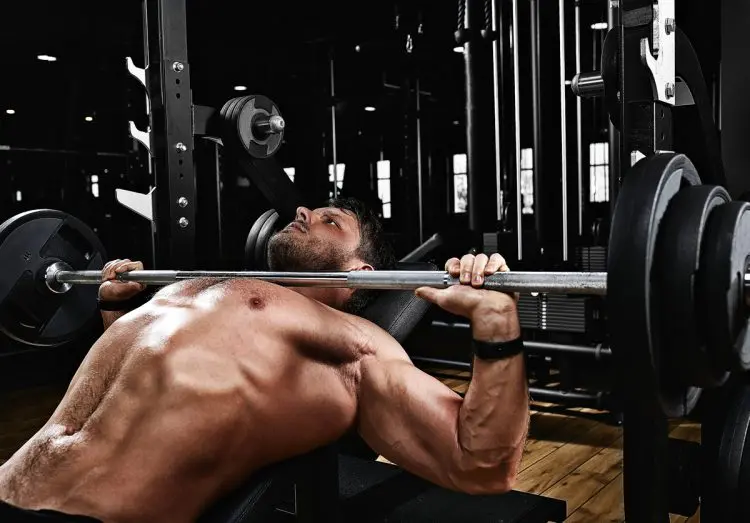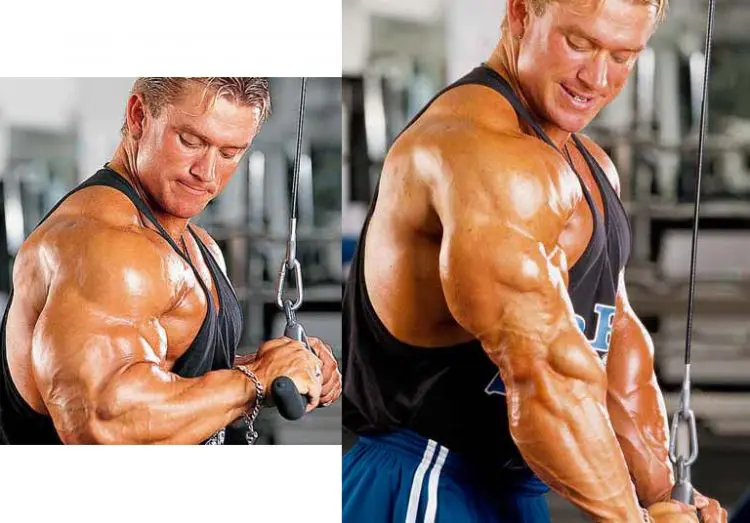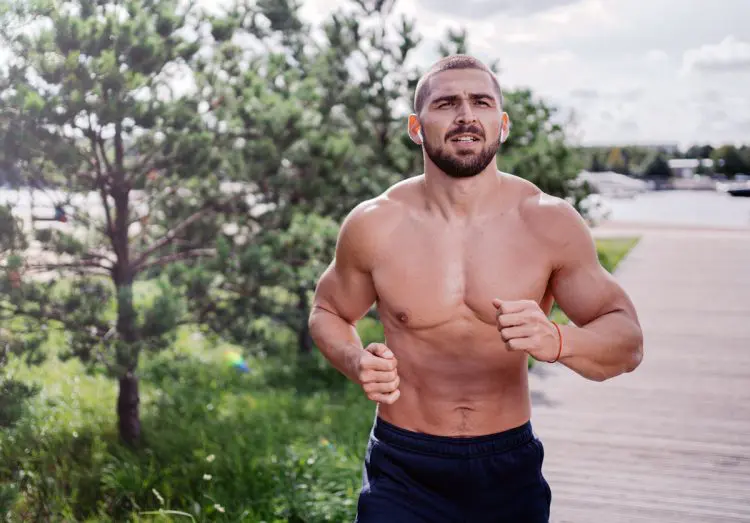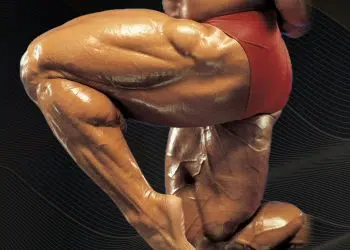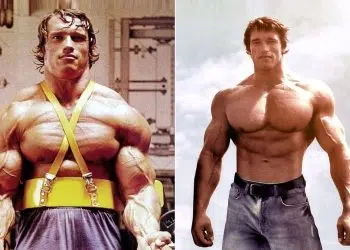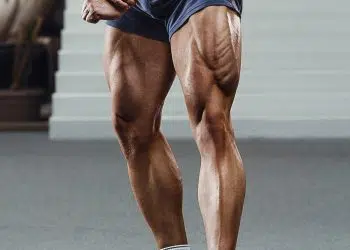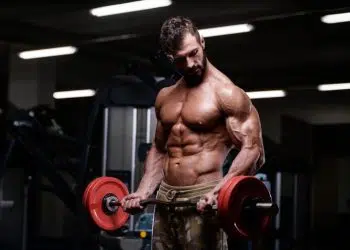As a veteran personal trainer with over 30 years of professional experience, it’s safe to say I’ve written thousands of programs for hundreds of clients. Some have been simple full-body workouts for beginners, while others have been complex split routines for elite athletes.
Regardless of who I’ve been writing programs for, I always ensure that the plan is viable and effective. After all, a good program should maximize your progress, whereas a poor one will bring it to a screeching halt!
For most exercisers, I usually recommend three or four strength workouts per week. This provides a good balance between work and rest for the average person. However, for more experienced lifters, I may suggest training five times per week using a 5-day workout split.
In this article, I explain the ins and outs of 5-day workout splits, provide some tried-and-tested examples, and discuss the pros and cons of high-frequency training.
What is a 5-Day Workout Split?
A five-day split involves training five days per week. In most cases, this means dividing your body into five body parts or muscle groups and working on each once per week. However, some five-day variations hit muscle groups twice per seven-day rotation. There is no “official” five-day split routine. Rather, it’s merely a framework into which you can slot the exercises you want to do.
What is the Main Goal of a 5-Day Workout Split?
The primary goal of the 5-day training split is to expose your muscles to more volume and intensity than they are used to. Five-day training splits are popular with bodybuilders looking to maximize hypertrophy or muscle growth.
Level Up Your Fitness: Join our 💪 strong community in Fitness Volt Newsletter. Get daily inspiration, expert-backed workouts, nutrition tips, the latest in strength sports, and the support you need to reach your goals. Subscribe for free!
With more workouts per week, you’ll have plenty of time and energy to dedicate to each muscle group. This could mean doing more exercises and sets per muscle group or hitting each muscle group more than once per week. An increase in training frequency may produce superior gains to training a muscle group only once a week. [1]
Needless to say, harder, I do not recommend such frequent workouts for beginner or early intermediate exercisers. Instead, 5-day workout splits are best left to more experienced lifters with several years of consistent training under their belts.
Sample 5-Day Workout Splits
There are lots of different interpretations of the five-day workout split. Design your own or follow one of my tried-and-tested examples.
But, before you start any of these workouts, make sure you spend a few minutes warming up and preparing your body for what you are about to do. Start with a few minutes of easy cardio to raise your core temperature and increase blood flow.
After that, do a few dynamic flexibility and joint mobility exercises for the body parts you are about to train. Finally, do a few easy sets of the main exercises in your workout to ensure you are as warm and ready to work as possible.
Regarding rest days, if you prefer to train on weekdays and take the weekends off, you are free to do so. However, a mid-week rest can also be beneficial. Try both options and see which one you prefer.
Adjust the following workouts to match your training goal:
| Training Goal | Endurance | Hypertrophy | Strength/Power |
| Intensity | Low | Moderate | High |
| Load | <67% of 1RM | 67-85% of 1RM | >85% of 1RM |
| 1RM = 1-repetition maximum i.e., the maximum weight that you can lift once but not twice | |||
| Repetitions per set | 13-20 | 6-12 | 1-5 |
| Recovery between sets | 30-60 seconds | 1-2 minutes | 3-5 minutes+ |
5-Day Workout Split #1 – The Body Part Split
This is the simplest way to do a five-way workout split. Just divide your body into five muscle groups and train one per workout. Note the order of the workouts; similar muscle groups are kept far apart to allow for optimal recovery. This is critical when designing this type of program.
| Monday | Chest |
| Tuesday | Back |
| Wednesday | Shoulders |
| Thursday | Rest |
| Friday | Legs |
| Saturday | Arms and Abs |
| Sunday | Rest |
Exercises List
Chest
Back
Shoulders
Legs
Arms and abs
- Barbell curl
- Barbell skull crusher
- Alternating dumbbell curl
- Rope pushdown
- Hanging knee raise
- Cable crunches
- Cable wood chop
5-Day Workout Split #2 – Arm Emphasis
With this variation, you train two muscle groups per workout, and your arms get two workouts per week. This is a good option if your arms need a boost or you prefer more variety in your workouts. On the downside, this program will probably mean spending more time in the gym.
| Monday | Chest and triceps |
| Tuesday | Back and biceps |
| Wednesday | Quads and calves |
| Thursday | Rest |
| Friday | Shoulders and arms |
| Saturday | Hamstrings and abs |
| Sunday | Rest |
Exercises List
Chest and triceps
- Dumbbell bench press
- Incline dumbbell fly
- Pec deck
- Dumbbell overhead triceps extension
- Single-arm cable kickback
Back and biceps
Quads and calves
Shoulders and arms
- Arnold press
- Upright row
- Cable lateral raise
- Preacher curl
- Dip
- Concentration curl
- Reverse grip pushdown
Hamstrings and abs
- Stiff-leg deadlift
- Leg curl
- Single-leg Romanian deadlift
- Hip thrust
- Weighted plank
- Side plank
- Reverse crunch
5-Day Workout Split #3 – Upper/Lower/Push/Pull/Legs
Most 5-day workout splits train each muscle group once per week. Some lifters prefer more volume than this. The Upper / Lower / Push/Pull /Legs train each muscle group twice per week by combining two different split routines. For added variety, you could use different sets and rep schemes on different training days.
For example, sets of 5-8 reps for the first two workouts and 9-12 for the last three.
| Monday | Upper body |
| Tuesday | Lower body |
| Wednesday | Rest |
| Thursday | Push (chest, shoulders, triceps) |
| Friday | Pull (back, biceps, abs) |
| Saturday | Legs |
| Sunday | Rest |
Exercises List
Upper body
Lower body
Push (chest, shoulders, triceps)
- Dumbbell bench press
- Incline barbell bench press
- Pec deck
- Seated dumbbell shoulder press
- Lateral raise
- Triceps pushdown
- Barbell kickback
Pull (back, biceps, abs)
- Weighted pull-up
- Seated cable row
- Standing cable pullover
- Barbell drag curl
- Barbell reverse curl
- V-sit
- Russian twist
Legs
5-Day Workout Split – Pros
The 5-day workout split is popular because it works. For many lifters, it provides the ideal way to build muscle and strength. The main pros of training five days a week are:
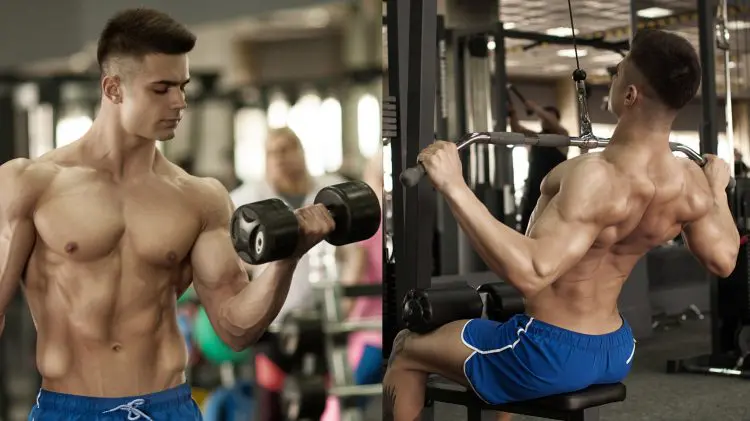
Plenty of training volume per muscle group
With most 5-day split programs, you train just one or two muscle groups per workout. This gives you more than enough time to do plenty of sets. Training volume is important for hypertrophy (muscle growth). Training more muscle groups per workout usually means a lower volume.
You can work your muscles from lots of different angles
With an entire session dedicated to one or two muscle groups, you’ll be able to use a variety of exercises to hit your muscles from all available angles. For example, instead of just doing squats for your legs or bench presses for your chest, you’ll be able to include many more exercises that may increase hypertrophy and sculpt a more aesthetically pleasing physique.
Increased caloric expenditure
Training five times a week means you’ll be expending plenty of energy. This could help you get leaner, lose weight, or maintain your current body weight without the need for additional cardio. For many exercisers, this is the ideal solution for building muscle and shedding unwanted fat.
Ideal for weekday exercisers
Many exercisers like to keep their weekends free. The five-day workout split is ideal for this purpose. Just train Monday to Friday, and rest Saturday and Sunday. After two days off, you’ll be ready to get back in the gym and start again on Monday.
A good balance between training and recovery
The 5-day workout split provides a good balance between work and rest. By rotating muscle groups, you avoid overloading any one body part, and two days off per week will provide a welcome break from training. For most lifters, this is a better approach than training six or more days per week, which can lead to overtraining.
5-Day Workout Split – Cons
While the 5-day workout is popular and can be very effective, it is not without drawbacks. Consider the following before you try the 5-day training split for yourself:
A big commitment
Training five days a week is a big commitment. Just one missed workout will unbalance your entire training week and could lead to underdeveloped muscle groups. If you are always short on training time or tend to skip workouts, this is not the training split for you.
You’ll need to pay attention to rest and recovery
Following a five-way split will take a lot out of your body. After all, there are only two rest days per week. Because of this, you’ll need to pay extra attention to nutrition, rest, and recovery. Sleep is also critical for optimizing progress.
It could lead to overtraining
While an hour or so is a suitable time for training large muscle groups, it may be too long for smaller body parts. For example, just because you’ve got an hour to train your arms doesn’t mean you should. Modify your training volume according to the muscle you are training to avoid overdoing it. An hour of biceps or calf training could be counterproductive.
Level Up Your Fitness: Join our 💪 strong community in Fitness Volt Newsletter. Get daily inspiration, expert-backed workouts, nutrition tips, the latest in strength sports, and the support you need to reach your goals. Subscribe for free!
Not really suitable for beginners
If you are new to strength training, a five-day workout split will probably be too advanced for you. All that volume and variety could leave you feeling tired and sore. A three-day or four-day split is a better choice for most beginners. You can step up to training five days a week when you’re ready.
Requires careful planning
If you write your own 5-day workout split, you need to be careful not to place similar muscle groups on consecutive days. For example, if you trained your chest on Monday, your shoulders on Tuesday, and your triceps on Wednesday, you will end up doing three “pushing” workouts in a row.
You also need to be mindful of stacking too many hard workouts in a row. For example, doing legs one day, back the next, and chest the day after could leave you overtrained, sore, and demotivated.
In addition, avoid overlapping closely related muscle groups to prevent overtraining, provide adequate recovery, and ensure that you have plenty of energy for your workouts. For example, it’s generally not a good idea to do chest one day and shoulders the next, as both workouts involve upper body pushing.
Make sure you consider all these points when designing your own five-day split routine.
Not a lot of time for cardio
If you like to do weights and cardio, you may find the five-way split too restrictive. While you COULD do cardio after strength training, you will probably find that you run out of energy. Doing cardio on your rest days could also interfere with recovery. If cardio training is important to you, a three or four-way split may be more productive. That way, you can do cardio between strength workouts.
Deciding Which 5-Day Workout Split is Best For You?
Which workout split will suit you better will depend on your fitness goal, training experience, and athletic abilities. Your training split will vary depending on whether you are training for strength, hypertrophy, weight loss, or improved athletic performance.
Actually, there can be countless permutations and combinations while designing a training split. If you aren’t sure where to start, I suggest consulting a qualified professional and working with them to create your ideal program. However, I feel that most people could start with the 5-Day workout split #1 presented in this article.
Recommended Supplements for 5-Day Workout Splits
While you can build muscle and strength without supplements, a few well-chosen products may help you make better progress. However, none will make up for too little sleep, a poor diet, or inconsistent workouts. A few supplements that you may find helpful include:
Multivitamins
A multivitamin supplement can be very helpful during high-intensity training. The body loses vital minerals and vitamins through sweating, and it’s important to replenish those lost micronutrients.
Vitamins are necessary for energy production, immune system functioning, and other functions. On the other hand, minerals play an important role in regulating various hormones. Adding a multivitamin supplement to your routine is the first step to ensure that your body has all the essential vitamins and minerals required to function optimally and recover efficiently.
Whey Protein
Whey protein helps your muscles recover faster. Plus, it’s fast digesting, accelerating muscle recovery when consumed after a workout. For people who find it difficult to reach their daily protein intake goals, whey protein is a convenient way to supply essential amino acids to the muscle fibers.
Casein Protein
The majority of muscle recovery happens when you are in deep sleep. While sleeping, our body releases various hormones that help in growth and recovery. Casein is a slow-release protein that supports muscle recovery by steadily providing the required amino acids throughout the night.
Creatine Monohydrate
Creatine is an amino acid located mostly in your muscles and brain. It can be found in fish, meat, and other animal products such as dairy. Creatine monohydrate has been proven to improve exercise performance, support recovery, improve lean-muscle development, and help lift heavy weights.
Creatine monohydrate is one of the most researched sports supplements that does not have side effects. International Society of Sports Nutrition states, “There is no compelling scientific evidence that the short or long-term use of creatine monohydrate (up to 30 g/day for five years) has any detrimental effects on otherwise healthy individuals or among clinical populations who may benefit from creatine supplementation.” [2]
Related: Creatine Calculator – Find Your Ideal Daily Intake
Frequently Asked Questions
1. Who are 5-day workout splits for?
5-day workout splits are for anyone looking to build muscle and strength. They can also be helpful for fat loss while preserving muscle mass. However, the high volume and increased frequency associated with this type of training mean 5-day workout splits are only suitable for late-intermediate and advanced exercisers. Beginners should follow a less demanding workout schedule.
2. Are five days enough to build muscles?
Yes, if you are giving your 100 percent to the training and sticking to your calorie goals, then training 5-days a week is more than enough to build muscles. However, it’s important to remember that it’s not your split that drives muscle growth, but how hard and consistently you are training.
3. Is a 5-day workout split better than a 4-day workout split?
Training five days a week is not automatically better than a 4-day split – especially if you have issues with recovery or find it hard to get five workouts into your schedule. In fact, you can build muscle with as few as 2-3 workouts per week if you work hard and consistently.
In summary, choose the split that best fits your needs and goals, and don’t assume that more workouts per week mean better results, as that’s not always the case. Even the “perfect” routine won’t do much for you if it’s not right or you cannot perform it consistently.
4. Can I do two leg workouts per week in a 5-day workout split?
Two leg workouts per week are a great way to ensure your legs aren’t underdeveloped or bring them up if they’re lagging behind. In fact, your legs get two workouts in our upper/lower/push/pull/legs routine, outlined above. I suggest most of my clients do two leg workouts per week, as well-developed legs are the foundation of every great physique.
5. Is a 5-day split good for weight loss?
Weight loss requires a calorie deficit. This means you must consume fewer calories than you burn, or burn more calories than you eat. We also call this a negative energy balance.
Providing you have a calorie deficit, a 5-day split can help you lose weight. However, if you are in a calorie surplus, you’ll probably gain muscle and weight instead. Consequently, you should adjust your diet to reflect your body weight/body composition goals.
6. Is it necessary to take a rest day if you split your workout days by muscle group?
Rest days are critical for muscle repair, recovery, and growth. That doesn’t mean you need to take a complete break from physical activity, but you should have a couple of non-training days per week. The five-day split provides two rest days a week, which should be enough for you to recharge your body and mind.
That said, if you don’t feel recovered, you should pay more attention to your diet and sleep. if you still feel overtrained, you should consider switching to a four-day workout plan, so you have more time off training.
7. Can I change the exercises in the sample programs?
The sample programs are examples of how you can organize a 5-day training split. As such, you are welcome to make whatever changes you wish. For example, you could do dumbbell bench presses instead of barbell bench presses, or leg presses instead of hack squats. However, stick to the general format of each workout to ensure whatever you create is as effective as possible.
Do you have further questions about 5-day workout splits? Then please drop me a line below, and I’ll get back to you ASAP!
5-Day Workout Split – Wrapping Up
While there is no single best 5-day workout split, there are several ways to use this popular training schedule. It’s ideal for intermediate and advanced bodybuilders who want plenty of time to train each muscle group from a variety of angles and with a decent amount of volume. You can also modify this approach so that you train each muscle group twice a week.
On the downside, training five times a week is a significant commitment in terms of time and energy. If you’re busy or struggle to recover between workouts, this may not be the split for you, and you may do better on a three or four-day split.
But, if you can stick with it, the 5-day workout split should deliver the desired results. Create your own or follow one of our proven variations.
References
- Evangelista A L, Braz T V, Teixeira C V L S, Rica R L, Alonso A C, Barbosa W A, Reis V M, Baker J S, Schoenfeld B J, Bocalini D S, and D’Andréa Greve J M. Split or full-body workout routine: which is best to increase muscle strength and hypertrophy. Einstein (Sao Paulo). 2021; 19: eAO5781.doi: 10.31744/einstein_journal/2021AO5781. PMID: 34468591
- Kreider R B, Kalman D S, Antonio J, Ziegenfuss T N, Wildman R, Collins R, Candow D G, Kleiner S M, Almada A L & Lopez H L. International Society of Sports Nutrition position stand: safety and efficacy of creatine supplementation in exercise, sport, and medicine. J Int Soc Sports Nutr 14, 18 (2017). doi: 10.1186/s12970-017-0173-z
Article Updates Timeline:
Our editorial team experts constantly update the articles with new information & research, ensuring you always have access to the latest and most reliable information.
December 21, 2023
Updated By
Patrick Dale, PT, ex-Marine
October 17, 2022
Updated By
Tom Miller, CSCS
April 7, 2021
Written By
Patrick Dale, PT, ex-Marine

